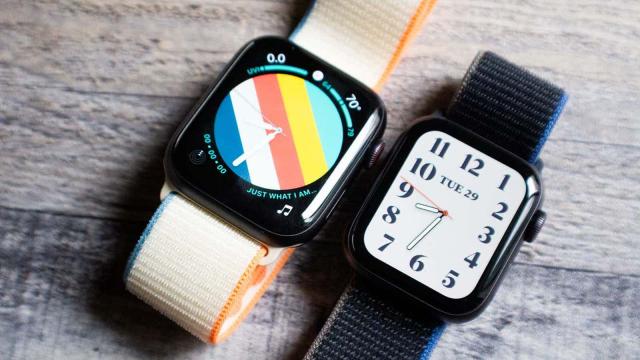According to a Wall Street Journal report, Apple is working on a number of advanced health features for the Apple Watch, including the ability to measure your blood pressure and body temperature. This is definitely in the realm of possibility, but just because Apple’s working on a feature doesn’t mean it’ll land on your wrist anytime soon.
While a number of new health features are reportedly in the works, the two marquee ones are blood pressure-tracking and a thermometer to help with fertility planning. Both are features that already exist on wrist-based wearables, albeit not in as sleek a package as the Apple Watch. Omron technically made the first FDA-cleared blood pressure smartwatch back in 2019, complete with an inflatable strap.
Samsung also has a blood pressure feature for its smartwatches, though it’s not available in the U.S. for regulatory reasons, and requires you to calibrate using a more traditional blood pressure-measuring device. Likewise, Ava is a fertility tracker that measures not only body temperature but also things like perfusion to help couples trying to conceive. Fitbit also added a body temperature sensor to its Sense smartwatch, and the Oura Ring has had one for ages.
It’s not groundbreaking that Apple is exploring these health features — everybody is doing it and has been for years. Aside from when it added FDA-cleared ECG sensors to the Series 4, Apple isn’t known for being the first to any particular health feature. Detailed sleep tracking, SpO2 sensors, and cardio fitness metrics have been around way before Apple added them to the Series 6 and watchOS 7. The point is Apple generally doesn’t tip its hand until it’s 100% sure what it’s got is good, or at least sufficient to meet its high standards. The potential lies in how Apple might refine the technology.
According to the WSJ report, Apple’s blood pressure feature would attempt to show users how their blood pressure was trending without the need for baseline systolic and diastolic measurements. (This is why Samsung needs calibration for its blood pressure feature.) Current smartwatch sensors can’t really do this, though that might not be the case for much longer. The WSJ says Apple is trying to approximate traditional blood pressure calibration devices by measuring the “speed of the wave a heartbeat sends through a person’s arteries.” Apple is reportedly exploring the ability to take readings without an inflatable cuff at all. This would be a big deal if the company could pull it off in a design similar to the current Apple Watch.
Apple may also add a temperature sensor to the watch in 2022 to help give women an idea of when they might be ovulating or detect fevers. Again, there are several fertility apps that give users basal body thermometers that do the same thing. Fertility window reminders are baked into period-tracking apps. Likewise, researchers began studying how wearables — including the Apple Watch — might detect infectious diseases using body temperature at the beginning of the pandemic. But again, Apple’s advantage here is that it’s in the middle of conducting a massive women’s health clinical study, and the findings there could offer clues that we don’t yet have due to a huge foundational gap in women’s health data.
Apple is reportedly also studying sleep apnea detection, alerts when blood oxygen levels drop, atrial fibrillation monitoring for those who have a confirmed diagnosis, and blood glucose monitoring for diabetes diagnosis and management. The latter was heavily rumoured for the Series 7, but it doesn’t look like we’ll be seeing that feature anytime soon either.
Most of these features have some kind of diagnostic element that would likely necessitate local health body clearance. Fitbit has been working on getting the FDA’s go-ahead on a sleep apnea feature since at least 2017 and we haven’t heard jack since last year. Apple’s current atrial fibrillation feature is only cleared to notify people who may not know they have the condition they’re at risk for it. It’s not cleared as a monitoring tool for those who do. The point is, this stuff takes a hefty amount of research, data collection, and time — and then it has to go through regulatory bodies before you and I ever get to try it out for ourselves.
Smartwatches made the shift from an overpriced phone accessory to a useful standalone gadget once watch makers invested in health features. But health tech doesn’t develop at the same speed as other technologies. There’s a higher degree of privacy and accuracy that needs to be taken into consideration, and on top of that, the medical community itself has to make sense of how to interpret consumer wearable data.
It took two years from when Apple first secured FDA clearance for its ECG feature to when Fitbit and Samsung also got the go-ahead in 2020. And still, many doctors are split on whether wearable data makes their jobs easier or harder. Apple may also scrap certain features because the technology isn’t there yet, or the liabilities involved are just too great for a consumer tech company.
It certainly does seem like the entire industry is standing on the precipice of something bigger and greater. There’s no question wearables have made gigantic strides since their resurgence in 2014. However, the more complex these devices become, the longer it will take to get these features ready for the average person. Listen, a slightly bigger screen was reportedly enough to delay production on the Series 7. It’d be a small miracle if we see most of these rumoured features in the next year, or even the year after.
